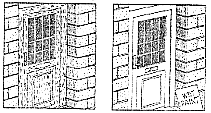
题目列表(包括答案和解析)
3. They are not serious enough.
他们不足够认真
enough作形容词时修饰名词,作副词时修饰动词、形容词及副词,其用法如下:
(1)enough修饰名词作定语时,既可修饰可数名词复数,也可以修饰不可数名词,而且大都放在所修饰的名词的前面,但不可以放在单数可数名词前来修饰单数可数名词。例如:
There’s just enough time to catch the train.
赶这班火车,时间正够。
We have enough seats for every one.
我们有足够的座位供大家坐。
同时enough 也可以放在名词的后面,尤其是在不可数名词之后。例如:
There was pizza enough for everybody to have a piece.
比萨饼足够每人一块。
We have food enough for fifteen people.
我们的食物够十五个人吃的。
(2)当enough用来修饰动词、形容词和副词时,必须位于此类词的后面。例如:
She is brave enough a student to attempt the course.
她是一个有足够勇气选这门课程的学生。
The water in the sea is warm enough to swim.
海里的水足够暖和能游泳。
The boy is clever enough to solve the problem.
这个孩子足够聪明,他能解出这道题。
2. I don’t think twelve-year-olds should be allowed to get their ears pierced.
我认为十二岁的孩子不应该允许穿耳眼。
(1)当主句中的谓语动词是think, suppose, believe, imagine, expect, calculate, be supposed to, appear等时,其否定句一般是否定的从句。例如:
I don’t think it’s a good idea.
我认为那不会是一个好主意。
I didn’t think he was clever.
我认为他不聪明。
I don’t suppose that’s true.
我认为那不是真的。
I don’t suppose I’ll trouble you again.
我估计不会再打扰你了。
I don’t believe he will succeed.
我相信他不会成功。
(2)twelve-year-olds指的是twelve-year-old boys / girls.
(3)get their ears pierced 是“get+名词+过去分词”结构,一般来说此结构有三种含义:
<1>让某人做某事。例如:
I can’t get the work done by anybody.
我找不到人来干这项工作。
When are you going to get your hair cut?
你打算什么时候去剪头发?
<2>自己完成某事(或自己参与完成某事)。例如:
The farmer got his planting done before the rain came.
这位农民在雨季来临之前干完了他的种植工作。
I can’t get the car started.
我无法把汽车开动起来。
Did you get the picture finished all right?
你顺利地完成了那幅画吗?
<3>遭遇某事。例如:
He got his wrist broken.
他折断了手腕。
He got his nose broken playing football.
他踢足球时把鼻子碰坏了。
1. Teenagers should be allowed to choose their own clothes.
中学生应该被允许选择他们自己的衣服。
(1)allow与permit两个词的意思与用法相近。permit比allow更正式,allow在非正式的英语中较为常见。
<1>这两个词后面都可以跟宾语+动词不定式。例如:
We do not allow / permit people to smoke in the hall.
我们不允许人们在大厅里吸烟。
<2>如果没有人称宾语,就用动名词。例如:
We do not allow / permit smoking in the hall.
我们不允许在大厅里吸烟。
<3>在被动句里,可以用人作主语,也可以用动名词作主语。例如:
People are not allowed / permitted to smoke in the hall.
在大厅里不允许人们吸烟。
Smoking is not allowed / permitted in the hall.
大厅里不允许吸烟。
<4>allow在本句子中是用在含有情态动词should的被动句子。
(2)own作形容词,意思是“自己的,其本身的,特有的”。own的用法如下:
<1>own只能在所有格词语的后面使用。例如:
They go to work in their own cars.
他们开自己的车去上班。
He did it in his own way.
他以自己的方法做这件事。
He’s his own boss.
他自己能做主张。
<2>own可以在后面没有名词的情况下使用。例如:
This bicycle is my own.
这辆自行车是我自己的。
May I have it for my very own?
这件东西只给我一个人好吗?
<3>of one’s own置于名词之后,意思是“自己的……,特有的……”。例如:
I want a computer of my own.
我想要一台自己的电脑。
We’ve got a house of our own now.
现在我们有自己的房子了。
<4>own构成的习惯用语有:
come in one’s own 本来的价值被承认
hold one’s own (在竞争中)坚守自己的立场,不屈服
of one’s own doing 自己做的
on one’s own 独自,靠自己
(3)should在本句中是情态动词,意思是“应该……,应当,最好……,理应”,是比must和ought to 更为委婉的说法。例如:
You should apologize to the old man.
你应该向那位老人道歉。
You should not eat too greedily.
你不应该如此贪吃。
My teacher said I should study harder.
老师说我应该学习更努力。
You should join the English club.
你应加入英语俱乐部。
6. 不能用于被动语态的几种情况
(1)当主动结构中的宾语是反身代词和相互代词时,不能改为被动语态
He saw himself in the mirror.
他在镜中看见了自己的模样
We often help each other.
我们常常互相帮助。
(2)当谓语是表状态的及物动词时(如have, like, take place, belong to …)
如:
I like these flowers. 我喜欢这些花。
I will have a meeting.
不说A meeting will be had.
应说A meeting will be held.
4. 由情态动词形成的被动语态
含有情态动词的句子在变为被动语态时,在情态动词后面加上be动词即可,其句型如下:
肯定句:主语+情态动词(can, may, must)+be+过去分词…
否定句:主语+情态动词+not+be+过去分词…
疑问句:情态动词(Can, May, Must)+主语+be+过去分词+…
如:We should allow teenagers to surf the Internet.
→Teenagers should be allowed to surf the Internet.
Can you use it? 你会使用它吗?
→Can it be used?
3. 含有短语的主动语态变被动语态。
不及物动词没有宾语,因此没有被动语态。但有的不及物动词后面加上介词及其他一些词类构成短语动词之后,其作用相当于及物动词,可以接宾语,因而也可以变为被动语态。在变成被动语态时,不能去掉构成短语动词的介词或副词。
They take good care of my child.
My child is taken good care of.
他们把我的孩子照顾得很好。
I turned off the radio.
The radio was turned off (by me)
附:动词短语的被动语态
take care of →be taken care of
cut down→be cut down
laugh at →be laughed at
look after→be looked after
下列这些短语本身即是被动语态的形式,不需再加-by
be covered with … 用…覆盖着
be interested in … 对…感兴趣
be surprised at … 对…感到惊奇
be made of (from) 用…制造的
5. 被动语态的几种类型:
(1)有两个宾语的句子的被动语态(直接宾语,间接宾语)
(一般是变间接宾语为主语)
常见的接双宾语的动词有
give, show, lend, send, bring(接to)
buy, make, draw(接for)
通常这种句子可以改为以“人”当主语,和以“物”当作主语的两种被动语态
如:
He gave me a book.
当直接宾语变为被动结构主语时,间接宾语前应加to / for
-I was given a book by him. (以I做主语)
-A book was given to me by Tom. (以物book作主语)
He teaches us English.
-We are taught English by him. (以人当主语)
-English is taught us by him. (以物作主语)
(2)含有宾语补足语的句子的被动语态
keep, make二类的动词常常有宾语补足语,在被动语态中,宾语补足语位置不变
We keep food fresh in the fridge
主 谓 宾 宾补
-Food is kept fresh in the fridge.
I saw him go into the office building.
-He was seen to go into the office building.
英语中有“十大动词”的说法,即feel, hear, listen, have, make let, look, watch, see, notice, 这些词在主动句中,其后的动词不定式不加to,但变被动句可必须加to.
4. 主动语态变为被动语态
把主动语态的句子变为被动语态的方法是:
(1)把原句中的宾语变为主语
(2)动词改为被动形式,即be+过去分词
(3)原来的主语,如果需要的话,放在by后面,如果没必要,可省略
主动语态变成被动语态应注意事项:
从主动语态到被动语态的过程中主语、谓语动词、宾语都发生变化。
注意主格与宾格的变化形式
注意主语的人称及数的变化对be动词带来的影响。
注意be动词的时态形式取决于原主动语态的动词时态形式。
3. 被动语态的用法
(1)不知道或没有必要说明动作的执行者是谁,不用by+动作执行者短语。
Such books are written for children.
这些书是为儿童写的。
I haven’t been told about it.
没有人告诉我这件事。
(2)强调动作的承受者,这时应用by短语
The cup was broken by David.
(3)作客观说明时,常采用一种被动语态句型
It’s / was said / believed / reported / + that…
It’s reported that about three hundred people were killed in this earthquake.
据报道,这次地震中大约有三百人死亡。
2. 被动语态的构成
(1)请大家看图

The office is cleaned every day.
The office was cleaned yesterday.
Compare active and passive:


动作的接受者the office成了句子的主语,就应该用被动语态,从上面的例句我们可以总结:
一般现在时的被动语态为:主+am / is / are (not)+过去分词
一般过去时的被动语态为:主+was / were+过去分词
如:Butter is made from milk.
This house was built 100 years ago.
以前我们学过的was / were born生于,就是一个被动语态
born是个过去分词(bear)
-When were you born? -I was born in 1989.
如果要特别强调动作或行为的执行者,句子后面需接by~,译为“被(由)…”
如:We were woken up by a loud noise.
我们被嘈杂的声音吵醒。
(2)请看图:


从上面例子,我们可以看出现在进行时被动语态的构成为
主语+is / am / are +being +过去分词
再如:My car is being repaired now
Some new houses are being built near the park.
公园附近在建一些房子。
(3)请看图

BEFORE NOW

从上面例子,我们可以看出现在完成时被动语态的构成为:
主语+have / has +been+过去分词
如:
My key has been stolen.
My keys have been stolen.
I am not going to the party, I haven’t been invited.
含有情态动词的被动语态
情态动词+be+过去分词
A note had better be left to him.
Teenagers should be allowed to wear their own clothes.
这里我们列举了几个主要时态,那么其它时态呢?
一般将来时 主语+will+be+过去分词
过去将来时 主语+would / should + be +过去分词
过去进行时 主语+was / were +being +过去分词
过去完成时 主语+had+been+过去分词
被动语态的时态是由be的时态决定的,be是什么时态,全句就是什么时态,be动词后面的过去分词不变。
归纳:
肯定句:主语+be+过去分词+(by~)
否定句:主语+be not+过去分词+(by ~)
一般疑问句:Be +主语+过去分词+(by ~)?
特殊疑问句:疑问词+be+主语+过去分词+(by ~)?
湖北省互联网违法和不良信息举报平台 | 网上有害信息举报专区 | 电信诈骗举报专区 | 涉历史虚无主义有害信息举报专区 | 涉企侵权举报专区
违法和不良信息举报电话:027-86699610 举报邮箱:58377363@163.com